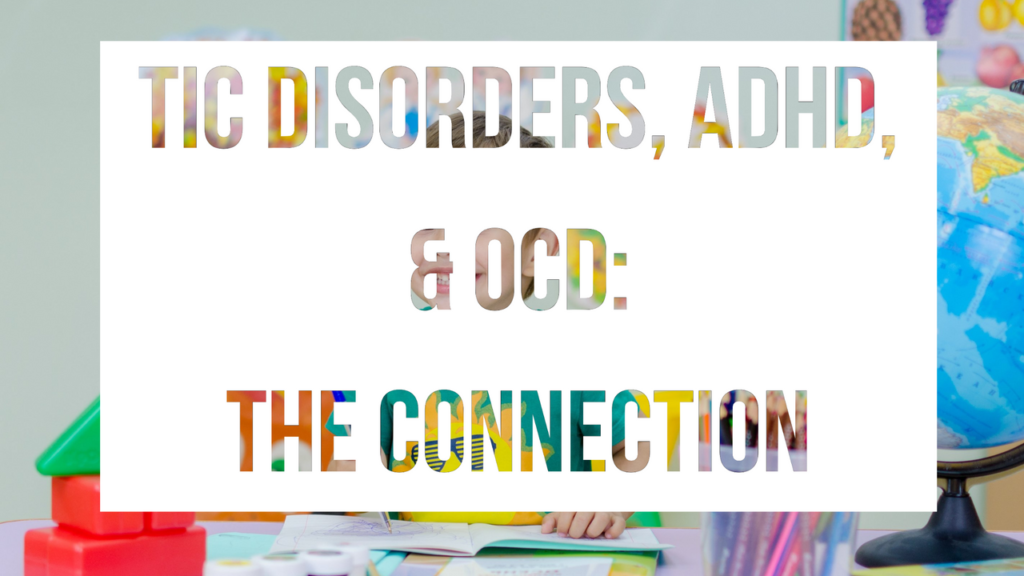As parents, we are always on the lookout for how to stop tics or tic disorders treatments but we don’t take into account how another diagnosis might be connected to tics.
Children who suffer from Tic disorders, ADHD, OCD, or Sensory processing are more likely to have another diagnosis. Tic disorders and other related diagnoses often go hand in hand with each other. A co-diagnosis is when a child has two different diagnoses that go together. Tics may be the most noticeable of these conditions, but they typically accompany one of these three: ADHD, OCD, or sensory processing disorder. We are going to explore tic disorders and how they relate to other mental health issues such as ADHD, OCD, SPD, and even autism spectrum disorders.
Tics may be observed in children diagnosed with ADHD. For example, a child with Tourette Syndrome (TS) accompanied by attention deficits will meet the diagnostic criteria for Attention Deficit Hyperactivity Disorder (ADHD). Tic disorder is also comorbid with other impulse control or disruptive behavior disorders such as Conduct Disorder and Oppositional defiant disorder that are often seen alongside a diagnosis of ADHD. In addition, tics can occur alone or co-occur with another neurodevelopmental issue like autism spectrum disorder. Children suffering from tic disorders usually have more than one motor or vocal tic, and they may also struggle with moods swings and focus issues.
If your child has more than one diagnosis, I am sure you wonder how they are all connected? For example, tic disorders, ADHD, SPD, OCD, and ASD, can be connected through similar brain mechanisms.
The connection between Tic Disorders, OCD, and SPD
We know tics often co-occur with another diagnosis, tics share a common neurological pathway responsible for developing these three conditions, which involve the basal ganglia area in our brains. The basal ganglia play an important role in regulating behavior, cognition, emotions as well as movement. Basal Ganglia function can be disrupted when our child has a multitude of hidden stressors impacting their bodily functions. You have heard me say in previous posts that all body systems are connected, and when one system malfunctions, they all become imbalanced.
A disruption in the immune system can lead to tics, ADHD, and OCD due to allergies, toxins, underlying infections, gut issues, and even food sensitivities. Unfortunately, tic disorders are often misdiagnosed because of a lack of understanding about what tics truly represent. Tics usually begin before the age of 18, but they may appear later on during adulthood if one has had chronic stressors impacting their body. These chronic stressors (allergies, toxins, underlying infections, gut issues, food sensitivities) can lead to inflammation, leaky gut syndrome, and more.
Tics and OCD often go hand in hand when underlying infections are present, causing inflammation in the brain. PANS and PANDAS are the key diagnoses when these two symptoms suddenly appear. Tic disorders don’t just affect children either- many adults struggle with these conditions as well!
When your child has multiple diagnoses, it is always important to go back to the hidden stressors and inflammation that are most likely at the root of the problem. For example, tics and OCD are stress-related conditions, so removing the Tic-causing stimuli is crucial in helping your child feel at ease.
Approaches for reducing tic symptoms include:
– Dietary changes to remove offending allergens/sensitivities (gluten, dairy, soy) as well as high histamine foods
– Probiotics and digestive enzymes to heal leaky gut syndrome and reduce inflammation of all types. Word of caution here, not all probiotics are created equal and because kids with tics are so sensitive ceratin probiotics may make tics worse.
– Addressing any underlying infections such as Lyme disease, strep, and parasites can be hidden causes of tics and OCD symptoms. For example, parasites cause elevated cytokine levels, which induce sensory sensitivities just like allergies do! Therefore, it’s important to test for these if you suspect them because your doctor most likely will not run a stool test.
-Removing environmental toxins and heavy metals as many neurological disorders have been associated with higher levels of heavy metals and environmental toxins in the body. Toxins can be found in many places, including pesticides sprayed on foods or used to spray our lawns! Therefore, it is important to eat organic, whole, unprocessed food whenever possible.
-Addressing biotoxins like mold and candida, biotoxins (like mold and candida) may trigger an immune response within the brain, causing tics and OCD symptoms.
Our children’s bodies need to recover from the inside out, and we need to remove any obstacles for this process to happen. Tic disorders also have a higher rate of comorbidity with other diagnoses than most neurological concerns, so it is helping address these conditions simultaneously while addressing underlying causes.
Are you ready to connect the dots and find out why your child is experiencing that long list of symptoms and diagnoses? Then, grab the Tic Disorder Cheat Sheet and start with my Five Functional Steps to start reducing tic symptoms now. You can grab the cheat sheet here.

